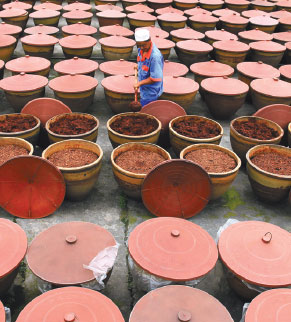 |
| A worker is making pepper, which is a major ingredient in many dishes from Sichuan cuisine. |
The old dam's longevity can mainly be attributed to a schedule of annual repairs, which date back to the Han dynasty (206 BC-AD 220), and tell the story of the hard work and foresight of local people.
Another popular place to explore the area's history is the Temple of Marquis Wu Museum, also known as the Wuhou Shrine.
The landmark honors Zhuge Liang (AD181 - 234),who is recognized as the greatest and most accomplished strategist of his era - the Three Kingdoms period (AD220-280).
Zhuge has become synonymous with intelligence and strategy in Chinese culture and visitors can get a better understanding of Chinese culture and values by visiting the shrine, said a museum official.
Chengdu citizens created the world's first paper currency - the Jiaozi in AD1023, in the western city's Jiangcong Temple, also known as the Thousands of Buddha's Temple.
The world's earliest natural gas was first discovered in the city too. During the Western Han Dynasty (206BCAD24), Chengdu's citizens discovered natural gas and used it to make salt. During the Tang Dynasty (AD618-907) Chengdu people had some of the best paper printing technologies.
We recommend:
